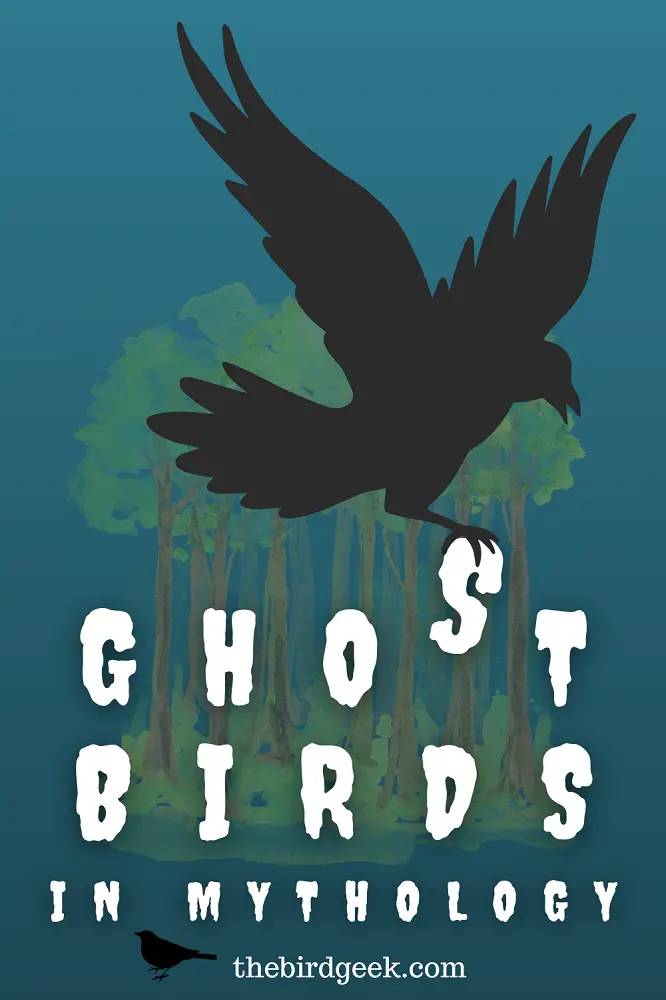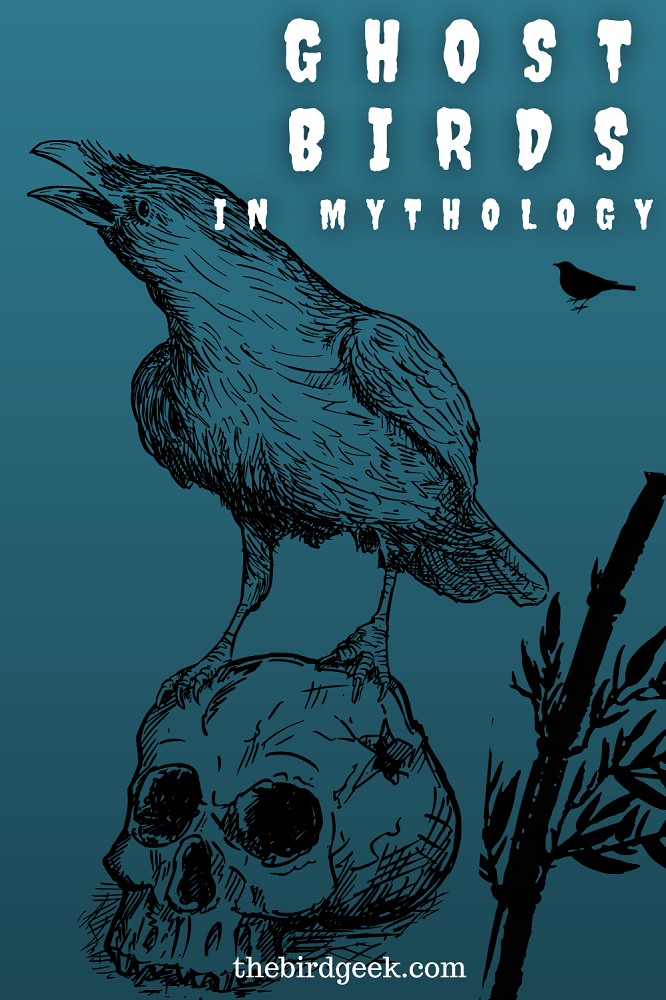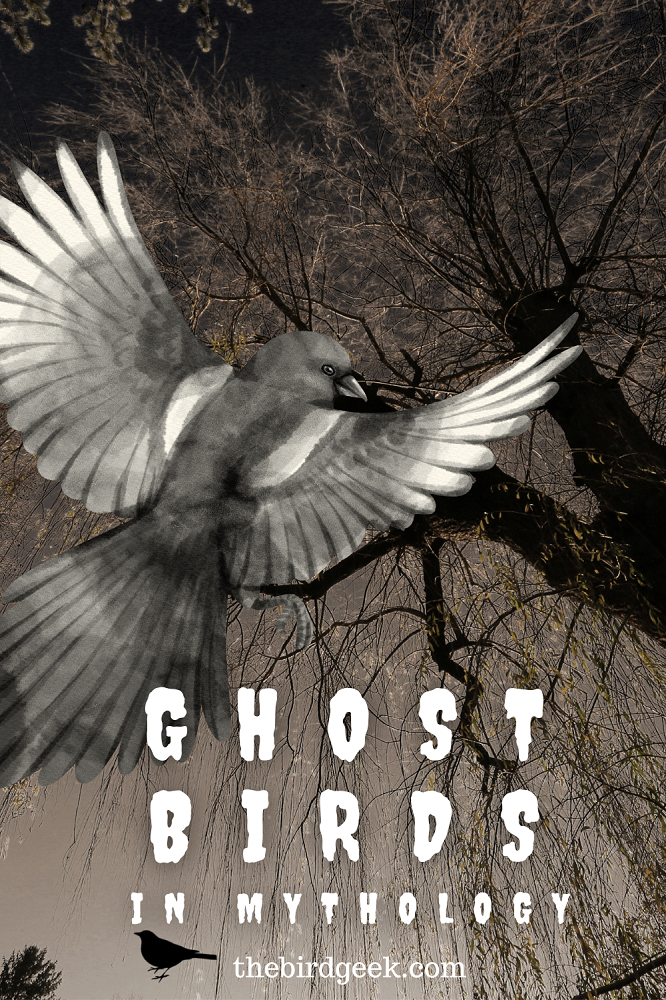Ghost Birds in Mythology
Birds feature heavily in multiple mythological traditions and are often portrayed as positive influences. They are also considered spiritual or elusive elements because of their ability to fly. As a result, there are many ghost birds in mythology that are fascinating and fun to understand.
Furthermore, there is also a real-life ghost bird species that has caught the attention of many people. No, it’s not actually a ghost, but it has a haunting appearance and call that makes it more than a little spooky. Let’s take a deep dive into this subject to learn more.
Ghost Birds in Mythology

The sheer number of ghost bird myths worldwide can probably be attributed heavily to nocturnal birds like owls or even bats. These beautiful myths show cultures trying to explain inexplicable things using whatever means they were available at the time.
Asian Ghost Birds: A Terrifying Tradition
In China, there are many mythological birds that are worth studying. The GuhuoNiao birds are heavily connected to a woman ghost YeZingYouNv or TianDiShaoNV. This ghost is also called Ubume in modern Japanese mythological traditions and is a bird that appears late at night and which hides during the day. It was heavily featured in the book XuanZhongJi.
GuhuoNiao can change its shapes by taking off or putting on a feather coat and is something of a boogieman-type character in Chinese and Japanese mythology. It doesn’t have and cannot have children, so it will kidnap children and raise them as its own. If she sees any children’s clothes outside at night, such as if a child left clothes outside, the items were marked with blood dots.
The GuhuoNiao would then return to the clothes and steal the child to raise them as its own. It would also steal any children that it found outside during the night. Furthermore, it is also believed that this bird can suck people’s souls, with the Japanese explaining that it was because she died during labor, transformed into a bird, and now wants children of its own. Women who died during labor were often said to be victims of the GuhuoNiao, and her children were marked by it for theft.
Furthermore, Chinese mythology also connects this creature with the nine-headed birds. These birds appear as women in a field and fly away, leaving just one behind. A farmer marries her and has three daughters that later fly away from the man. These birds also drop blood and stain homes to mark them for disaster and steal souls.
Related post: Read through our collection of Owl Names in Mythology!
Other Mythological Ghost Birds
Just about every culture has some variation of a ghost bird variation. For example, the Greeks and Romans believed that all birds were messengers to the heavens, as well as death omens. Egyptian tradition particularly focused on hawks, and stories feature ghostly birds who move between spiritual realms. These traditions remain prevalent even today, as many Egyptians believe birds are an ill omen of death. Other traditions that include ghost birds include:
- Aztec: According to ancient Aztec religious myths, the dead are reborn as birds known as “Colibris”. These birds are heavily associated with the god Huitzilopochtli. As a result, Aztecs avoided harming birds when possible and would openly communicate with them as if they were ghosts.
- African Cultures: In West African traditions, various tribes would tie birds to corpses and kill it so that it would carry souls to the afterworld. The idea was that killing the bird would release its spirit or soul and help it perform its duty more easily.
- South Sea Islands: While the South Sea Islands didn’t sacrifice birds with their dead, they did bury them in bird-shaped coffins. They believed that this coffin shape would invite a bird spirit to come for the souls of their dead and take them to the heavens.
- Ireland: Ireland’s folktales are full of fantastic bird stories, particularly about seagulls. These common birds were spread wildly throughout Ireland and were believed to be the souls of drowning victims. As a result, sailors would treat seagulls with respect and dignity while fishing.
- Greek and Roman Myths: Ancient Greece and Rome share many mythological traditions, including the Strix. This bird was one of ill omens and fed on human flesh and drank its blood. They were also connected to witches and other similar malevolent beings. They were heavily connected to spiritual matters and can be compared to modern demons.
Many cultures also believe that wild birds flying into a home is an omen of critical news, often death. Birds that fly against windows or die on impact or also considered a promise of death. Nocturnal birds are considered ghostly and frightening, such as owls. Bats, often mistaken for birds, were also considered harbingers of death, probably related to their tendency to spread rabies.
Related post: Famous Falcon Names in Mythology
What Bird is the Bringer of Death?

Many cultures believe that birds are not just spiritual messengers but harbingers of death. Let’s look at a few of the most popular of these birds to give you an idea of how widespread this belief is throughout the world:
- Cardinals: Cardinals are often thought of as a reminder of a deceased loved one. They’re not quite the bringer of death, but they are often thought of as a loved one coming to visit you after they have passed away. Hummingbirds also have a similar connotation.
- Crows: Crows have varying connotations in multiple traditions. For example, many societies consider them to be the bringer of death, such as the Welsh belief that a crow flying over a house predicts death in that home. Others believe that crows are good luck and should be appreciated for their intelligence.
- Rooster: This common game bird was typically found on almost every farm throughout Europe and the Americas. When it crows at night, many cultures believe that death is coming soon. Similarly, if a rooster does not crow at daybreak, death may be close at hand.
- Ravens: Ravens, with their large size and intensely black color, is often considered an obvious sign of death. The most obvious example is Edgar Allan Poe’s legendary poem, “The Raven.” However, other cultures connect ravens with death and consider them a messenger of the spirit realm.
- Owls: The familiar image of the owl as a kindly and intelligent creature belies an ancient tradition associated with death and negativity. In China, India, and ancient Rome, owls were considered the bringers of death and were avoided as much as possible.
- Vultures: As a bird of carrion, vultures have an obvious connection with death. Some look at this negatively and believe that they’re a bringer of death. Other cultures honor the vulture as a crucial transitional spirit that takes the dead to the afterlife before rebirth.
What is the Real Ghost Bird?
Several years ago, a video featuring a large and frightening bird garnered a lot of attention online. The woman who took the video captured a bird with very large eyes and an expansive mouth that sat comfortably on a fence in Chilbolo in Magdalena. As she approached the bird, it screamed in a haunting manner. Many people called the video a fake, but it is completely real.
The woman was lucky enough to have captured video of the Great Potoo, an elusive bird that is often called the “ghost bird.” They are found heavily throughout South America and look like an owl, but they are not in the same family. Often, the Great Potoo is hard to spot because its plumage blends in so well with trees, stumps, and other wooden items. The woman taking this video initially thought it was a stick or stump.
The Great Potoo may be the source of many ghost bird myths because of its startling appearance and frightening cry. Imagine living in an ancient civilization and coming upon a stick at night that suddenly transforms into a bird and flies away. Even worse, the Great Potoo has a slit in its eyelids that lets them see danger while its eyes are closed, which makes its sudden reactions even more frightening.
Related post: Hawk Names in Mythology
Wrap up- Ghost bird Mythology

Birds can fill many roles in mythology, and different cultures view different birds in different lights. Traveling around the world, you may find that birds from seagulls to vultures, to owls, are associated with death and ghosts. And of course, there are other mythological ghost birds depending on culture.
Related post: Water and Ice Birds in Mythologies
References:
